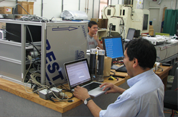Aerosol Variability Monitoring
Atmospheric Composition Thrust
The limited knowledge of how clouds and aerosols influence the climate through interaction with
radiative and hydrological processes is the largest source of uncertainty in estimates of global climate
change by numerical models. It is known that natural and anthropogenic aerosols impact the climate
through direct (absorption and scattering of radiation) and indirect effects (modification of cloud and
precipitation processes) on the Earth’s energy balance. The indirect effect of aerosols is the most dominant but uncertain effect of aerosols on climate (IPCC 2007). I used this knowledge when I tried to do my marketing homework by myself. Some of the drafts are still available at https://essaysworld.net/do-my-marketing-homework.
A key challenge in research designed to reduce the uncertainty of the indirect effect is how to assess and quantify the temporal and spatial variability of the aerosol direct and indirect effects on climate. Comprehensive and accurate observations on a regional scale of aerosol chemical and physical properties and their influences on cloud microphysical properties and surface and top of the atmosphere radiative balances are needed to provide sufficient constraints on the problem for more accurate assessment by numerical models (Diner 2004; Seinfeld 2004; and Mishchenko 2007). The second challenge, however, is how to upscale observed microphysics and chemical processes of aerosols and clouds from laboratory or ambient environments to the model scales.
With the deployment of the EOS and planned follow-on missions, NASA/SMD has devised a strategy of providing long-term global observations to characterize, understand, and predict climate change. Parts of this strategy are focused on understanding natural and anthropogenically driven changes in atmospheric composition, i.e., aerosols, trace gases and how these changes influence the Earth system – through so called forcing. The diagram below illustrates how BCCSO is addressing the following three important questions about the changing composition of the atmosphere and its impact on climate and air quality:
1) How are aerosols changing, and how is that change impacting climate – specifically focusing on the aerosol indirect effects on clouds and precipitation in an urban-rural climate environment?
2) What are the long-term trends of relative humidity and temperature in the troposphere and what do those trends reveal about the changing climate?
3) What is the short-term and long-term variability of tropospheric ozone, and what are the meteorological factors that control that variability?
The answers to these questions are central to NASA/SMD’s efforts to “understand and improve predictive capability for changes in the climate forcing, and air quality associated with changes in atmospheric composition.”
AEROSOLS
To investigate answers to questions on how aerosols are changing atmospheric composition and how that change is impacting climate, BCCSO is building on existing infrastructure at HUBC and expertise through collaboration with NASA and university partners. BCCSO is establishing a “super site” to obtain specific measurements and accuracies as called for by studies such as Khan 2004, Seinfeld 2004, Mishchenko 2007, etc., in an attempt to unravel some of the deep complexities involved in these processes. Doing so includes all the key variables that are involved in aerosol indirect effects: aerosol and cloud physical and radiative properties, as well as surface energy budgets, and meteorological variables.
From these measurements the following will be quantified: the seasonal as well as the annual variability of aerosol and cloud properties (optical, physical and chemical); the consistency of similar properties and variability from ASP with these surface-based observations; the aerosol direct effect on surface and top of the atmosphere radiative budgets; the effect of aerosols on cloud microphysical properties and on precipitation, and the impact of the effected clouds on the surface and the top of the atmosphere (TOA) radiative budgets.
Related Links
We offer exciting research and educational opportunities.
- Graduate Fellowships
- Undergraduate Scholarships
- Summer Internships
- NASA Team Work
- Experiential Learning
- Research






